Exploring Hydrofoil Boards in Kiteboarding
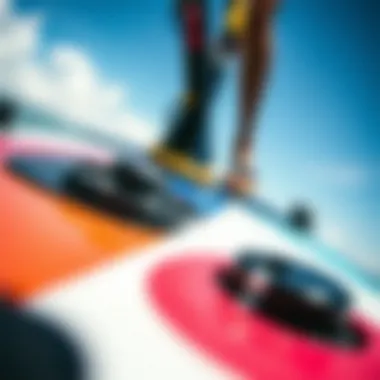

Intro
Kiteboarding has come a long way, with various innovations enhancing the experience on water. One such revolutionary advancement is the hydrofoil board. This technology has brought an extraordinary shift in the way kiteboarders interact with both the water and wind. Hydrofoil boards lift riders above the surface, reducing drag and allowing for smoother rides even on lighter winds. As we delve deeper into the dynamics of hydrofoil boards, it's crucial to understand the specific gear involved, the skills required, and the practical considerations to make the most out of this thrilling segment of kiteboarding.
Gear Selection
When it comes to hydrofoil kiteboarding, the right gear can make all the difference. Selecting suitable equipment isn't just about personal preference; it can significantly influence a rider's performance and enjoyment.
Types of Kites
Hydrofoil kiteboarding requires special attention to the types of kites used. Not all kites provide the same lift or power in lighter winds. Enthusiasts should consider:
- Foil Kites: These kites are often favored for hydrofoiling. They generate substantial lift and are more efficient in low wind conditions. The membranes provide a solid structure, allowing riders to maintain speed effortlessly.
- Leading Edge Inflatable Kites (LEI): While these are more common in general kiteboarding, they can also work for hydrofoiling. However, they may require consistent wind to perform optimally.
Choosing the Right Board
Your choice of board is another key aspect of gear selection. With hydrofoils, the main considerations include:
- Size of the Foil: A larger foil provides more lift but can be harder to control, while a smaller one might offer more agility, suited for advanced riders.
- Board Length: Longer boards typically facilitate easier takeoffs, whereas shorter boards allow for more dynamic turns. Riders should choose based on their skill level and riding style.
- Weight and Material: Lightweight boards made from carbon fiber or similar materials help in achieving better performance and can offer a more responsive feel on water.
Skill Development
Leaning into hydrofoil kiteboarding isn’t just about gear; mastering the techniques and honing your skills are just as crucial.
Essential Techniques
Riding a hydrofoil board requires different techniques compared to traditional kiteboarding. Here are some essentials to keep in mind:
- Starting from the Surface: It’s vital to maintain balance as you begin. Finding the sweet spot where you can pop up onto the foil is key.
- Maintaining Speed: You need to keep your kite powered and maintain an even pace to stay lifted on the foil.
- Control and Subtle Movements: Small adjustments in body weight and foot positioning can significantly impact your ride. Avoid oversteering to maintain stability.
Progression Tips
As you venture deeper into hydrofoiling, the following tips can assist in your development:
- Practice in Light Winds: Begin in calmer conditions to build confidence.
- Watch Experienced Riders: Observing skilled kiteboarders can provide insight and maneuvers you might want to emulate.
- Join a Community: Engaging with others who share the passion can help accelerate skill growth.
"Hydrofoiling isn’t just a trend; it’s a transformative experience that allows riders to connect with the elements in a unique way."
Closure
The integration of hydrofoil boards into the realm of kiteboarding signifies a remarkable evolution within the sport. By understanding the gear requirements and mastering essential skills, riders will not only enhance their experience but also build a deeper appreciation for this extraordinary activity. Whether you're just starting out or looking to refine your technique, the right approach and gear can elevate your kiteboarding journey to new heights.
Preface to Hydrofoil Boards
In the expansive world of kiteboarding, where innovation meets adrenaline, hydrofoil boards have emerged as a revolutionary element. Understanding hydrofoil technology is imperative for modern kiteboarders, as it offers new dimensions of speed, efficiency, and maneuverability on the water. Hydrofoiling allows riders to experience a sensation akin to flying above the waves. This new wave of technology invites kiteboarders to explore beyond traditional limits, making it a subject of intense interest.
Defining Hydrofoil Technology
Hydrofoil technology revolves around the principle of lift, which is generated by the unique shape of the hydrofoil wings. These wings, submerged beneath the water's surface, create a pressure difference that lifts the board above the water as the rider gains speed. Unlike conventional boards that glide directly on the water, a hydrofoil board elevates, greatly reducing drag and allowing for smooth gliding even in choppy conditions. The absence of a flat surface in contact with the water minimizes resistance, often resulting in higher speeds.
In simpler terms, when the board speeds up, the wings cut through the water, lifting the rider out of the waves. This setup not only enhances speed but can also result in an exciting ride with less turbulence. Riders often describe the feeling of hydrofoiling as "floating on air," providing a particularly liberating experience.
History of Hydrofoil in Water Sports
The origins of hydrofoil technology in water sports date back to the mid-20th century, primarily pioneered by the likes of inventor Bob Woodward and others who experimented with different wing designs. While the concept of using foils beneath the water’s surface isn't new, its applications in kiteboarding gained traction in the early 2000s.
Initially, hydrofoils were popularized in windsurfing circles, where riders sought to conquer the winds without being weighed down by the water. As kiteboarding began to gain momentum, the advantages of hydrofoils quickly caught the attention of enthusiasts. The transition from windsurfing to kiteboarding allowed for greater versatility, and soon, a flurry of hydrofoil designs started appearing on the scene. Various manufacturers began producing user-friendly models that catered to both seasoned kiteboarders and newcomers alike.
The adoption of hydrofoil technology has shaped new competitions and communities within kiteboarding, pushing riders to refine their skills in previously unthinkable ways. Today, hydrofoils are not seen just as a passing fad but rather as a major advancement in the sport, inspiring countless kiteboarders around the globe to uplift their riding experience. This offers a unique perspective on riding dynamics, challenging the limits of traditional kiteboarding methods and encouraging continual innovation within the sport.
How Hydrofoil Boards Work
Understanding how hydrofoil boards work is essential for any kiteboarder looking to elevate their experience on the water. The mechanics behind these boards play a crucial role in improving performance and enhancing the overall riding experience. Hydrofoil technology is unique because it allows riders to lift above the water's surface, significantly reducing drag and increasing speed. This fascinating principle not only alters the dynamics of kiteboarding but also broadens the range of conditions in which you can comfortably ride.
Principles of Lift and Drag
At the core of hydrofoil functionality are the principles of lift and drag. Lift is the force that allows the board to ascend above the water, while drag refers to the resistance created as the board moves through the water. Essentially, as the hydrofoil moves forward with speed, the specially designed wings create a pressure differential, generating lift. This movement can feel like taking off in an aircraft; once the initial speed is achieved, the board rises, and the rider glides over the water. The key takeaway is that a well-tuned hydrofoil can elevate the rider to a new realm of speed and efficiency.
Components of a Hydrofoil Board
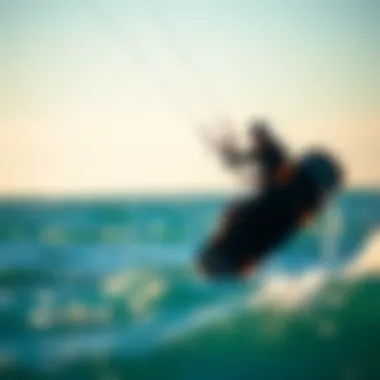
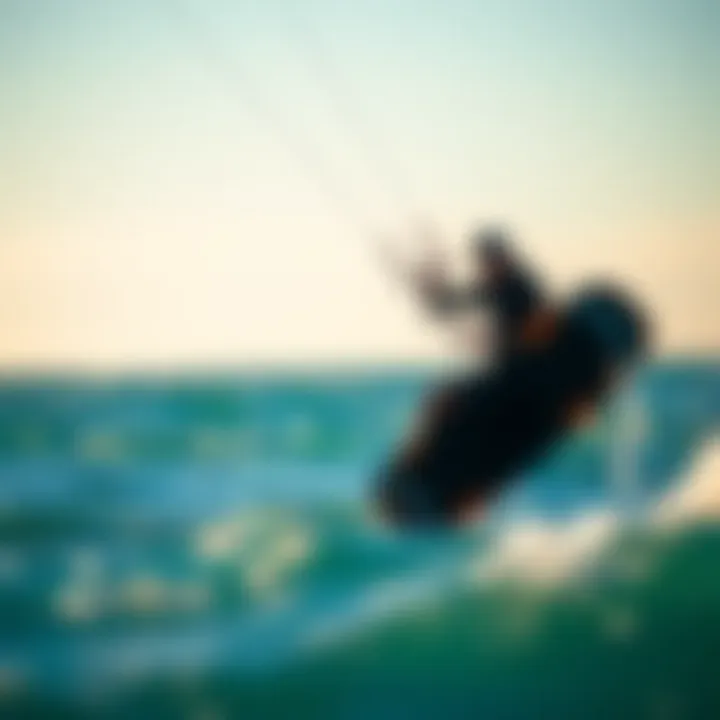
The construction of a hydrofoil board is integral to its performance and efficiency. Each component contributes significantly to the overall functionality, embracing the aquatic dynamics in a unique way. The essential parts include:
Fuselage
The fuselage acts as the backbone of the hydrofoil. It's the central piece which connects the wings and the mast together. A key characteristic of the fuselage is its length; longer fuselages can offer more stability at higher speeds, while shorter ones allow for more maneuverability. One unique feature of modern fuselages is the ease of attachment to the mast, making adjustments straightforward. This usually results in better customization for the rider's preferences.
Mast
The mast is the vertical component of the hydrofoil system that rises from the board to the foil wings below the water. Its height is crucial, as a taller mast allows the rider to navigate through waves and obstacles without compromising on lift. Commonly made from materials like aluminum or carbon fiber, the lightweight construction is a defining aspect of the mast. One advantage of a carbon fiber mast is the reduced flex, providing a stiffer ride which can enhance performance in choppy conditions.
Wings
Wings are arguably the most critical component in a hydrofoil setup. They are shaped specifically to maximize lift while minimizing drag. Diverse wing styles cater to different riding conditions, such as flat water or choppy waves. A significant advantage of a well-designed wing is its ability to maintain lift with less speed, allowing for a smooth and efficient ride. Variations in the aspect ratio and surface area can notably impact performance, with wider wings generally facilitating easier lift at slower speeds.
Board
The board itself serves as the base for the rider. Hydrofoil boards tend to be shorter and more compact compared to traditional kiteboards. This design minimizes drag and ensures that the rider can efficiently transfer power from the kite into upward lift. A unique characteristic is the incorporation of footstrap attachments, which provide stability and a secure connection to the board during dynamic maneuvers. However, the shorter length might take some getting used to, particularly for riders more familiar with standard kiteboards.
Interactions with Kite Dynamics
Kites play a significant role in how hydrofoil boards function. The interaction between kite dynamics and hydrofoils involves understanding how the kite's power translates into lift for the board. A properly tuned kite can enable a seamless ride by providing consistent power. Adjustments to kite size and the angle of attack can influence not just the lift but also the rider's ability to control the board. With hydrofoiling, this connection becomes even more pronounced, as maintaining the right balance of power is essential to optimizing the riding experience.
The harmonious interaction among all these components of hydrofoil systems, along with an understanding of the principles that govern them, creates a unique riding experience. It is this intricate relationship that opens up a world of possibilities for kiteboarding enthusiasts.
Advantages of Hydrofoil Boards
Hydrofoil boards, a revolutionary development in the kiteboarding scene, offer a distinct set of advantages that enhance the overall riding experience. Understanding these benefits can aid kiteboarders in making informed decisions when they look to upgrade their gear. In this section, we will delve into the key advantages of hydrofoil boards: improved speed and glide, reduced water resistance, and extended riding conditions.
Improved Speed and Glide
One of the standout features of hydrofoil boards is their ability to achieve higher speeds with less effort compared to traditional boards. This is achieved primarily through the lift generated by the hydrofoil beneath the water's surface. When the board rises above the water, it effectively eliminates most of the drag, allowing the rider to accelerate more quickly and reach speeds that can be downright exhilarating.
To put it simply, when you’re hydrofoiling, you're not fighting against the water as much. Instead, you ride on this magical cushion of air that forms above the water's surface when the foil is working as intended. Riders often report a surreal sensation of flying, which is particularly appealing for adrenaline junkies seeking the thrill of speed.
- With hydrofoil boards, novice riders can also experience a greater sense of buoyancy that reduces the likelihood of face-plants, making the learning curve a bit more forgiving.
- Moreover, the efficiency of hydrofoiling enables experienced kiteboarders to travel longer distances in shorter timeframes.
Reduced Water Resistance
Another major advantage of hydrofoil boards lies in their ability to minimize water resistance. Traditional kiteboards rely heavily on their surface area to push against the water, which creates friction and slows down momentum. On the contrary, hydrofoils lift the board out of the water, significantly lowering that frictional drag.
The reduced water resistance means that hydrofoil riders can maximize their energy output. This translates to being able to harness gusts and lulls in wind with more effectiveness, thus optimizing each session. For instance:
- Wind Efficiency: Hydrofoil boards perform well in lighter winds, allowing kiteboarders to ride during conditions that would typically be considered unfavourable.
- Smoother Rides: The hydrodynamic shape of the hydrofoil evens out choppy waters, leading to a more stable ride when compared to conventional kiteboards.
Extended Riding Conditions
The versatility of hydrofoil boards is particularly noteworthy regarding the variety of conditions they can handle. Since hydrofoiling allows for riding in very shallow waters, kiteboarders are not limited to ideal spots with perfect wave patterns or deep channels. They can explore lakes, rivers, and even coastal areas with limited water depth.
This opens up an entirely new playground for enthusiasts eager to experiment with diverse environments. Riders will discover:
- Year-Round Riding: Whether it's summer sunshine or winter breezes, hydrofoil boards can be used across multiple seasons and conditions.
- Access to Untamed Locations: Adventurous riders are sometimes able to reach previously untouched waters, pushing the boundaries of where one can kiteboard.
"Hydrofoil boards are changing how and where we kiteboard, giving us access to places we never thought possible."
Challenges of Hydrofoil Boards
When it comes to hydrofoil boards, the conversation often centers around their impressive abilities in the water—speed, lift, and the overall thrill factor. However, it’s essential to hold the mirror up to the challenges they present. Understanding these challenges can not only help potential riders prepare effectively but also enhance their overall kiteboarding experience.
Learning Curve for New Riders
Soon after stepping onto a hydrofoil board, new riders often feel a mix of excitement and trepidation. The learning curve can be steep, akin to trying to learn a tricky dance without a partner. Unlike traditional kiteboards, hydrofoils require precise balance, core strength, and coordination between the kite and the board to achieve flight above the water.
Many riders find that the initial attempts can be frustrating, with repeated falls becoming the norm rather than the exception.
- Patience is Key: Newcomers should anticipate some bumps along the way, as mastering the art of hydrofoiling demands time and practice. Specifically, learning how to maintain balance on the board while keeping the kite in a favorable position is crucial.
- Instruction Matters: Seeking professional guidance or joining local riding groups can significantly speed up the learning process. Instructors can share tips they learned the hard way, preventing many rookie mistakes and enhancing safety.
In essence, those who approach hydrofoiling with a willing heart and mind, and a commitment to practice, will gradually find their rhythm and enjoy the mesmerizing sensation that comes with riding on a hydrofoil.
Equipment Costs and Maintenance
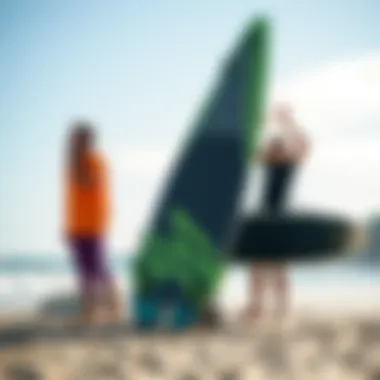

Let’s face it—picking the right gear can be as complex as solving a puzzle with missing pieces. Hydrofoil setups can often carry a hefty price tag, and the costs can be a significant consideration for many aspiring riders. A good quality hydrofoil board, like those made by brands such as Slingshot or Naish, can set you back significantly more than traditional kiteboards. In this realm, getting what you pay for often rings true.
- Initial Investment: Buyers often need to factor in the board, the hydrofoil itself, and the associated accessories. Sometimes, the total investment can feel overwhelming. However, skimping on quality can lead to not just poor performance but could also affect safety.
- Maintenance Considerations: The maintenance required for hydrofoil boards can be different from standard boards. Regular checks on the foil's hardware, ensuring everything is snug, and monitoring for wear and tear are important. For instance, ensuring that the fuselage and wings show no signs of corrosion or damage is crucial, especially for those who often ride in saltwater.
Investing in proper gear is largely beneficial in the long run. Quality equipment not only extends the lifespan of the board but also enhances the overall riding experience.
Safety Considerations
While hydrofoiling undoubtedly presents a thrilling adventure, it’s vital to address safety considerations that come along for the ride. With the board lifting above water, one might think they’ve left potential hazards behind. This isn't necessarily the case—agility and strategic awareness are critical.
- Collision Risks: Riders should be acutely aware of their environment. The elevator-like lift can lead to faster speeds, meaning potential collisions with other riders, boats, or obstacles can happen in a flash. Practicing in designated areas helps mitigate this risk.
- Safety Gear: Wearing safety gear, such as a well-fitted helmet and impact vest, should never be an afterthought. Even the most experienced riders can miscalculate their movements, and the foil's unique design can cause injuries if mishandled.
“Safety first; it’s better to ride smarter than harder.”
In summary, challenging conditions often arise with hydrofoiling, but with the right mindset, preparation, and respect for safety measures, riders can navigate their way through the steep learning curve, invest wisely in equipment, and enjoy their time on the water. Engaging with the community and learning from others can also bolster your hydrofoiling journey, transforming challenges into valuable experiences.
Choosing the Right Hydrofoil Setup
Selecting the proper hydrofoil setup is crucial to maximize your experience in kiteboarding. With various types of hydrofoils available, each tailored to specific styles and skill levels, understanding your personal needs and riding conditions can significantly enhance your performance on the water. Key factors to consider when choosing the right hydrofoil setup include the type of hydrofoil, the size of the board, and the size of the kite you plan to use. This section provides detailed insights into each of these elements, ensuring that you make a well-informed decision that aligns with your kiteboarding aspirations.
Selecting a Hydrofoil Type
- Freeride:
The freeride hydrofoil is designed for those who are looking for a smooth ride with an emphasis on versatility. Its major characteristic is its stability, which makes it a perfect choice for riders transitioning from traditional boards. Freeride foils typically have a more generous wing area that enhances lift and allows for easier takeoffs. This type of hydrofoil is especially beneficial for beginners and intermediate riders, as it provides a forgiving experience when learning to ride. However, it might lack some speed compared to racing foils, making it less ideal for advanced riders seeking high performance. - Race:
The race hydrofoil is built for speed and performance, making it an attractive option for competitive kiteboarders. With narrower wings and a streamlined design, these foils excel in reaching high speeds and cutting through water with minimal resistance. The key advantage of race foils is their ability to maintain consistent speed over distance, making them suitable for long races or course events. However, they can be less stable at low speeds, which might pose a challenge for less experienced riders. Investing in a race hydrofoil requires a serious commitment to improving your skills if you want to harness its full potential. - Freestyle:
The freestyle hydrofoil makes a statement with its agility and responsiveness, aimed at riders who want to perform tricks and maneuvers. One of its notable features is the unique wing shape that allows for quick turns and tighter rotations. Freestyle hydrofoils often have a shorter mast, providing increased control during aerial tricks. This type of foil is often favored by more skilled kiteboarders, as it requires a greater level of technical ability. The downside? It may not be the easiest setup for those still grasping the basics of hydrofoiling, as the learning curve can be steeper.
Matching Board Size to Skill Level
Choosing a board size that corresponds with your skill level is a fundamental aspect of achieving a satisfying riding experience. If you're just getting your feet wet, a larger board provides increased stability and buoyancy, making it easier to maintain balance. As you progress, a smaller board allows for improved maneuverability and control, letting you explore more complex techniques. Keep in mind, that the width and length of the board should work harmoniously with your hydrofoil for maximum effectiveness.
Finding the Optimal Kite Size
Your kite size plays a significant role in your overall hydrofoiling experience. A larger kite captures more wind, ideal for lighter conditions, but it requires greater skill to control effectively. Conversely, a smaller kite is easier to handle but may struggle in light winds. Finding a balance is essential; consider your weight, experience, and local wind conditions when selecting an appropriate kite size for your hydrofoil setup. Remember that sometimes less is more, and matching the kite to ideal conditions can lead to an exhilarating riding experience.
"The right setup transforms the hydrofoil experience from a mere pastime to an exciting adventure on the water."
Techniques for Mastering Hydrofoil Riding
Mastering hydrofoil riding is not just about physical skills; it involves diving into a blend of technique, timing, and mental focus. Each aspect contributes to the overall kiteboarding experience, enhancing both performance and enjoyment on the water. Understanding how to maneuver effectively on a hydrofoil can greatly widen a rider's capabilities, pushing boundaries and exploring new horizons.
Getting Started on a Hydrofoil Board
Starting out on a hydrofoil board can feel daunting, particularly for those who have primarily ridden traditional boards. Getting familiar with the setup and the feel of the foil is where learning begins. First off, ensure you’re wearing a helmet and impact vest, even if you’re just practicing basic maneuvers.
- Stable Base: Begin in shallow water. Start by just standing on the board in a stationary position. This helps in understanding weight distribution.
- Correct Stance: Your feet should be shoulder-width apart to maintain balance. Keep your knees slightly bent and your weight centered over the board.
- Small Adjustments: The moment you start to feel the board lift, use your body to make small adjustments. Leaning forward or backward just a bit will influence lift, affecting how the hydrofoil reacts on the water.
Perfecting Your Takeoff
Achieving a smooth takeoff is critical in hydrofoil kiteboarding. This phase demands timing, technique, and a fiddly balance. Here’s how to refine your takeoff:
- Kite Positioning: Start with your kite in a suitable position. A lower angle is often more effective for beginners, as it allows them to power up the board easier without overloading the foil.
- Build Speed: Gently begin by pulling on the kite and slowly edging the board, building up speed.
- Lift Off: As you gather speed, initiate a subtle shift in weight to your back foot. The instant the foil begins to lift, keep your body relaxed but engaged. If this feels scary, practice on a days with lighter winds initially.
Riding Techniques for Stability
Once you’re up and riding, maintaining stability becomes key to an enjoyable session. A solid grip on stabilization techniques will set the stage for further progression in hydrofoiling:
- Body Position: Keep your body aligned; imagine a line running from your head through your hips down to your feet. Avoid leaning too far to either side, as this can result in crashing down.
- Fluid Movements: Stay relaxed and let your hips steer the board. Avoid jerky motions as they tend to destabilize the ride.
- Weight Distribution: Experiment with shifting your weight between your heels and toes. This will help in managing pitch and roll, crucial for navigating and turning.
Advanced Maneuvers and Tricks
As you gain confidence and skill, you might find yourself wanting to explore advanced tricks. Here’s a peek into popular maneuvers:
- Tacks and Jibes: Mastering these helps in seamless transitions. They require precise control and timing, so practice them in different wind conditions.
- Jumping: Jumping on a hydrofoil can be exhilarating but also requires practice. Begin with small hops, focusing on how you land. Aim to land smoothly to avoid hard impacts on the water.
- Spins: Once you feel comfortable, you can attempt spins, which involve good kite control and balance. Using your body to initiate the spin while maintaining traction on the board is key to success.
"Practice doesn’t make perfect, but it does make better! As with any sport, repetition ot ways to mastery."
As you venture into hydrofoil riding, embracing every aspect of the experience will undoubtedly elevate your skill and enjoyment. Each small gain in skill will lead to greater confidence and a much richer time on the water.
Safety Protocols for Hydrofoiling
Safety is paramount in all water sports, and kiteboarding with hydrofoil boards is no exception. The sheer thrill of flying above the water can be exhilarating, but it also comes with its own risks. Adhering to safety protocols not only minimizes accidents but also enhances the overall experience for everyone involved. This section discusses essential safety measures that kiteboarders should practice, focusing on environmental awareness, equipment checks, and knowing emergency procedures.
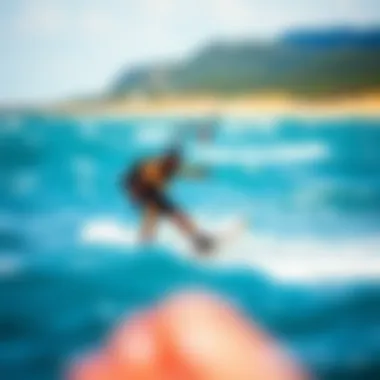
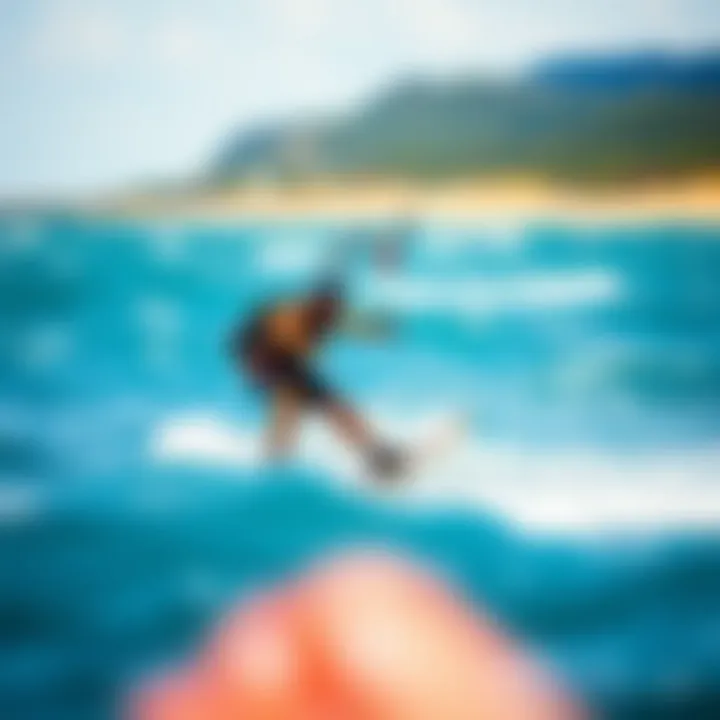
Understanding Environmental Conditions
Before hitting the water, it's crucial to assess the environmental conditions. Weather can change on a dime, especially on open water. Here are a few key aspects to consider:
- Wind Speeds: Ideal wind conditions for hydrofoiling typically range from 10 to 25 knots. Winds above this can lead to difficulty in control, making the rider more susceptible to accidents.
- Water Conditions: Smooth water with minimal chop is preferable. Choppy conditions can destabilize the rider, making it harder to maintain balance on the hydrofoil.
- Obstacles: Be aware of potential obstacles in the water, such as rocks, buoys, or even other water users. It's wise to have a clear view of the area before setting off.
- Local Regulations: Different locations have specific regulations regarding kiteboarding. Familiarizing yourself with these rules can prevent misunderstandings or legal issues.
Paying attention to environmental factors not only ensures safety but allows for a more enjoyable riding experience. Remember, a good rider is often one who is not just skilled, but also aware of their surroundings.
Equipment Safety Checks
A thorough equipment check before each session can save you from unexpected troubles. Here's a checklist for kiteboarders utilizing hydrofoil setups:
- Lines: Check for frays or knots. Damaged lines can lead to catastrophic failures while riding.
- Kite Condition: Inspect for punctures or tears. A seemingly small hole can lead to significant issues when airborne.
- Hydrofoil Setup: Ensure that the fuselage, mast, and wings are securely attached. Tighten screws and bolts. Any loose component can cause performance issues or accidents.
- Life Vest: Always wear a suitable Personal Flotation Device (PFD). It’s not just a legal requirement in many places but a lifesaver in emergencies.
By making safety checks a habitual part of your pre-boarding routine, you can glide onto the water with confidence.
Emergency Procedures
Despite thorough preparations, sometimes things don’t go as planned. Here’s how to effectively manage unforeseen situations:
- Falling Off the Board: If you find yourself taking an unexpected plunge, always aim to fall away from the board to avoid contact with the sharp edges.
- Assisting Others: If you see a fellow kiteboarder in distress, don’t hesitate to help. Approach slowly, and be conscious of the wind direction to avoid jeopardizing both your safety and theirs.
- Emergency Signals: Familiarize yourself with basic signaling to communicate distress. A raised arm can indicate that you need assistance.
- Heading to Safety: Know the closest safe spot to return to in an emergency. This can be a beach, boat dock, or designated safe area.
In emergencies, quick thinking and solid decision-making are vital. Practicing these procedures during calm conditions ensures you’re prepared when conditions aren’t.
The Future of Hydrofoil Kiteboarding
The horizon of hydrofoil kiteboarding is expanding, showcasing a dynamic interplay of technology, sport, and community. This topic is crucial as it encapsulates not just the evolution of equipment but also the growing popularity and accessibility of hydrofoiling. Enthusiasts are keenly observing the developments that feed into this adventure, as innovations can dramatically enhance performance and rider experience.
As the sport matures, understanding its future becomes paramount. Improvements in design and technology are set to reshape the playing field, providing riders with better tools for exploration and artistic expression on the water.
Emerging Technologies and Innovations
Emerging technologies are the lifeblood of hydrofoil kiteboarding. Manufacturers are keen to experiment with lightweight materials like carbon fiber, which reduce overall weight while maintaining durability.
Additionally, advancements in hydrofoil design, such as wings with optimized shapes for lift and stability, mean riders can experience smoother flights over water. The use of data analytics is becoming more prominent, too; sensors may soon offer real-time feedback to riders, aiding them in fine-tuning their skills and improving performance.
- Smart Hydrofoils: Early-adopters are integrating technology into hydrofoils, enabling features like adjustable wing angles and automated stability systems.
- Eco-Friendly Materials: As environmental awareness increases, manufacturers are exploring sustainable materials, paving the way for a more responsible approach in production.
These innovations not only promise to elevate the riding experience but also safeguard the environment, making hydrofoil kiteboarding more appealing to new riders.
Predictions for Market Growth
Market growth in hydrofoil kiteboarding is a hot topic among industry experts, and the outlook is optimistic. The rise in awareness around water sports and adventure activities, coupled with an increase in recreational spending, positions hydrofoiling as a rising star in the kitesurfing category.
- Increased Accessibility: As more people migrate toward coastal areas, access to watersports increases, and with it, the adoption of hydrofoils, particularly in regions that traditionally favored other water sports.
- Youth Engagement: Programs engaging younger audiences are paving the way for growth. Schools and clubs taking up hydrofoil kiteboarding can inspire future generations.
According to recent market analysis, the hydrofoil market could see significant growth over the next few years, driven by increased participation rates and evolving technologies.
Community and Competitive Events
The community surrounding hydrofoil kiteboarding is evolving and expanding, creating opportunities for fun, camaraderie, and competition. Events tailored to this niche have started cropping up across the world, and many existing kiteboarding contests are adding hydrofoil categories, demonstrating its acceptance as a serious competitive discipline.
- Local Competitions: Community-driven events allow riders of all skill levels to engage in friendly competition. These gatherings not only enhance skills but foster friendships and networks among kiteboarders.
- National and International Tournaments: Higher stakes competitions are gaining traction, spotlighting top riders and bringing attention to the sport. Events such as the Hydrofoil Pro Tour are attracting serious contenders and spectators alike, fueling excitement.
Through collaborations and sponsorships, the hydrofoil kiteboarding scene is ready to catch the wind in its sails, drawing more enthusiasts and participants into the fold, thus pushing its future into exciting new territories.
"The future is bright for hydrofoil kiteboarding; with the right innovations and community spirit, we can expect it to soar to new heights."
As we look ahead, it's clear that the future of hydrofoil kiteboarding harbors a landscape rich with possibility.
Closure
The importance of this article lies in its comprehensive exploration of hydrofoil boards within kiteboarding. Understanding these boards is not merely about the technology or tricks; it's about enhancing the overall kiteboarding experience. Hydrofoil boards present unique challenges and opportunities that can take a rider from an ordinary session to exceptional heights, quite literally. By dissecting the mechanics behind hydrofoils, their advantages, and their inherent challenges, readers glean insights essential for making informed decisions.
Summarizing Key Insights
Key insights from our discussion illustrate that hydrofoil technology transforms the way riders interact with the water. The lift provided by the wings raises the board above the surface, vastly reducing drag. This means riders can glide swiftly over less-than-ideal conditions, translating to a more enjoyable adventure on the water. Additionally, learning curves exist; mastering these boards requires patience and practice, but the rewards are profound. Riders often note an exhilarating sense of freedom, akin to flying just above the waves. Embracing hydrofoil technology can open doors to new experiences and expand one’s skills.
Encouraging Responsible Practices
As with any sport, responsible practices must guide the use of hydrofoil boards. Awareness of environmental conditions is crucial; busy waterways can pose risks, especially as beginners learn. Safety checks on equipment should never be overlooked. Ensuring that everything is working as intended isn't just about performance, it often relates to rider safety. Riding responsibly isn't just good for you; it's vital to the community and the environment. Joining local kiteboarding groups, like those on platforms such as reddit.com or facebook.com, allows enthusiasts to share tips and instill a culture of accountability and care.
"Safety first, adventure second!"
Through this narrative, we hope that readers don’t just view hydrofoiling as a trend but as an opportunity to engage with a rapidly growing community. The journey into hydrofoiling is rewarding, and with responsible practices, we can ensure it remains enjoyable for future kiteboarders.















